A Deep Learning-Based Unbalanced Force Identification of the Hypergravity Centrifuge
Abstract
1. Introduction
2. Deep Learning-Based Identification Methodology
2.1. GAF: Encoding Time Series as Images
2.2. ResNet: Convolutional Neural Network (CNN) Based on Residual Learning
2.3. Tweedie Loss: The Optimized Loss for an Imbalanced Dataset
2.4. Deep Learning-Based Unbalanced Force Identification Model
3. Data Description
3.1. Case Study: The ZJU-400 Hypergravity Centrifuge
3.2. Handcrafted Features and Correlation Analyses
3.3. Features Normalization Processing
4. Model Evaluation
4.1. Evaluation Criteria for Model Assessment
4.2. Experimental Setup
5. Results and Discussion
5.1. Model Development and Parameter Optimization
5.2. Performance Analysis of the Unbalanced Force Identification Model
5.3. Analysis of Identification Errors with Box-Plot
5.4. Balance Status Identification and Counterweight Evaluation during the Speed-Up Process
6. Conclusions
- The identification results of the ZJU-400 hypergravity centrifuge after training showed that the unbalanced force identification model proposed in this paper could accurately extract features from the shaft oscillation signal and reveal the complex relationship between features and unbalanced force. Consequently, the MAE, RMSE, and R2 of the test dataset were 0.452 tf, 0.668 tf, and 0.945, respectively. The proposed method obtained the best performance among the benchmark deep learning and machine learning methods. Specifically, it reduced the MAE by 15%~51% and the RMSE by 22%~55% compared with other benchmark methods, illustrating its high identification accuracy and stability. The model proposed in this paper also met the demand for quantitatively identifying unbalanced forces in hypergravity centrifuges without trial weight.
- According to the research results, Tweedie loss improved the identification performance in imbalanced datasets that exhibited long-tailed distributions, indicating a significant reduction in the identification error of large, unbalanced forces.
- During centrifuge speed-up, identification accuracy and stability were judged by assessing the consistency of the calculated unbalanced mass, and the correlation between the identified unbalance force and centrifugal acceleration. Accordingly, the unbalanced force identification method proposed in this paper achieved accurate identification and provided an evaluation for balancing counterweight in the centrifuge speed-up process, surpassing the strain sensor-based method by 75% in the MAE (accuracy), and by 85% in the median (stability).
Author Contributions
Funding
Institutional Review Board Statement
Informed Consent Statement
Data Availability Statement
Acknowledgments
Conflicts of Interest
Nomenclature
| List of symbols | |
| A random variable which obeys the Tweedie composite Poisson distribution | |
| A random variable conforming to the Poisson distribution | |
| Mean parameter of | |
| The variable ’s value | |
| Shape parameter of Gamma distribution | |
| Parameter of Gamma distribution | |
| Known function 1 | |
| Known function 2 | |
| Parameter defined on real number field | |
| Dispersion parameter | |
| The first derivative of | |
| The second derivative of | |
| Power parameter | |
| Actual value | |
| Regression value | |
| Unbalanced force | |
| Artificially added mass (unbalanced mass) | |
| Centrifugal acceleration at the bottom of the hanging basket | |
| Nominal rotational radius of the hypergravity centrifuge | |
| Ratio of circumference to diameter | |
| Rotating frequency | |
| Feature dataset | |
| Normalized feature dataset | |
| The mean of | |
| The standard deviation of | |
| Actual unbalanced force of the ith sample | |
| Identified unbalanced force of the ith sample | |
| The total number of samples considered | |
| The mean of the actual unbalanced force among the samples considered | |
| Median operator | |
| Variance operator | |
| Tweedie power parameter | |
| The unbalanced force identification result | |
| The actual unbalanced force | |
| List of acronyms | |
| FEM | Finite element method |
| SVM | Support vector machine |
| MTF | Markov transition field |
| GAF | Gramian angular field |
| ETR | Extreme tree regression |
| XGBoost | Extreme gradient boosting algorithm |
| CNN | Convolution neural network |
| DBN | Deep belief networks |
| ResNet | Deep Residual Network |
| Senet | Squeeze-and-excitation networks |
| ZJU | Zhejiang University |
| GASF | Gram angular sum field |
| GADF | Gram angular difference field |
| RBB | Residual building blocks |
| MAE | Mean absolute error |
| MSE | Mean squared error |
| RMS | Root mean square value |
| Xf | x times the rotating frequency |
| RMSE | Root mean square error |
| MedAE | Median absolute error |
| MTD | Mean Tweedie deviance regression loss |
| R2 | Coefficient of determination |
| STD | Standard deviation |
References
- Goodman, T.P. A Least-Squares Method for Computing Balance Corrections. J. Manuf. Sci. Eng. 1964, 86, 273–277. [Google Scholar] [CrossRef]
- Kang, Y.; Lin, T.; Chang, Y.; Chang, Y.; Wang, C. Optimal balancing of flexible rotors by minimizing the condition number of influence coefficients. Mech. Mach. Theory 2008, 43, 891–908. [Google Scholar] [CrossRef]
- Lei, W.; Han, J.; Chen, H.; Gong, X. The modified balance method based on precession decomposition. In Proceedings of the 2011 IEEE International Conference on Computer Science and Automation Engineering (CSAE), Shanghai, China, 10–12 June 2011; Volume 2, pp. 632–636. [Google Scholar]
- Edwards, S.; Lees, A.W.; Friswell, M.I. The identification of rotor unbalance from measured foundation response data. In Proceedings of the IMAC—Proceedings of The 17th International Modal Analysis Conference, Kissimmee, FL, USA, 8–11 February 1999; Volume 3727, pp. 1610–1615. [Google Scholar]
- Markert, R.; Platz, R.; Seidler, M. Model Based Fault Identification in Rotor Systems by Least Squares Fitting. Int. J. Rotating Mach. 2001, 2001, 311–321. [Google Scholar] [CrossRef]
- Sudhakar, G.N.D.S.; Sekhar, A.S. Identification of unbalance in a rotor bearing system. J. Sound. Vib. 2011, 330, 2299–2313. [Google Scholar] [CrossRef]
- Pennacchi, P. Robust estimate of excitations in mechanical systems using M-estimators—Theoretical background and numerical applications. J. Sound. Vib. 2008, 310, 923–946. [Google Scholar] [CrossRef]
- Pennacchi, P.; Vania, A.; Bachschmid, N. Increasing the robustness of fault identification in rotor dynamics by means of M-estimators. Mech. Syst. Signal. Pr. 2007, 21, 3003–3029. [Google Scholar] [CrossRef]
- Chatzisavvas, I.; Dohnal, F. Unbalance identification using the least angle regression technique. Mech. Syst. Signal. Pr. 2015, 50-51, 706–717. [Google Scholar] [CrossRef]
- Hübner, G.R.; Pinheiro, H.; de Souza, C.E.; Franchi, C.M.; Da Rosa, L.D.; Dias, J.P. Detection of mass imbalance in the rotor of wind turbines using Support Vector Machine. Renew. Energ. 2021, 170, 49–59. [Google Scholar] [CrossRef]
- You, L.; Han, Q.; Liang, Y.; Wang, J.; Jiang, X.; Zhang, C.; Song, Y. A classification method for rotor imbalance fault with ISFLA-SVM. In Fifth International Workshop on Pattern Recognition; SPIE: Stanford, CA, USA, 2020; Volume 11526, pp. 115260B-1–115260B-5. [Google Scholar]
- Tong, R.; Li, P.; Lang, X.; Liang, J.; Cao, M. A novel adaptive weighted kernel extreme learning machine algorithm and its application in wind turbine blade icing fault detection. Measurement 2021, 185, 110009. [Google Scholar] [CrossRef]
- Chen, J.; Hu, W.; Cao, D.; Zhang, B.; Huang, Q.; Chen, Z.; Blaabjerg, F. An Imbalance Fault Detection Algorithm for Variable-Speed Wind Turbines: A Deep Learning Approach. Energies 2019, 12, 2764. [Google Scholar] [CrossRef]
- Yan, J.; Kan, J.; Luo, H. Rolling Bearing Fault Diagnosis Based on Markov Transition Field and Residual Network. Sensors 2022, 22, 3936. [Google Scholar] [CrossRef]
- Cui, J.; Zhong, Q.; Zheng, S.; Peng, L.; Wen, J. A Lightweight Model for Bearing Fault Diagnosis Based on Gramian Angular Field and Coordinate Attention. Machines 2022, 10, 282. [Google Scholar] [CrossRef]
- Tuerxun, W.; Chang, X.; Hongyu, G.; Zhijie, J.; Huajian, Z. Fault Diagnosis of Wind Turbines Based on a Support Vector Machine Optimized by the Sparrow Search Algorithm. IEEE Power Energy Soc. Sect. 2021, 9, 69307–69315. [Google Scholar] [CrossRef]
- Chen, G.; Tang, X.; Lu, J.; Yang, R. Research on Fault Diagnosis of Rolling Bearing Based on CNN-ETR. J. Ordnance Equip. Eng. 2021, 42, 251–255, 275. [Google Scholar]
- Gu, K.; Wang, J.; Qian, H.; Su, X. Study on Intelligent Diagnosis of Rotor Fault Causes with the PSO-XGBoost Algorithm. Math. Probl. Eng. 2021, 2021, 9963146. [Google Scholar] [CrossRef]
- Xie, W.; Li, Z.; Xu, Y.; Gardoni, P.; Li, W. Evaluation of Different Bearing Fault Classifiers in Utilizing CNN Feature Extraction Ability. Sensors 2022, 22, 3314. [Google Scholar] [CrossRef] [PubMed]
- Xing, S.; Lei, Y.; Wang, S.; Jia, F. Distribution-Invariant Deep Belief Network for Intelligent Fault Diagnosis of Machines Under New Working Conditions. IEEE T Ind. Electron. 2021, 68, 2617–2625. [Google Scholar] [CrossRef]
- Bang, J.; Di Marco, P.; Shin, H.; Park, P. Deep Transfer Learning-Based Fault Diagnosis Using Wavelet Transform for Limited Data. Appl. Sci. 2022, 12, 7450. [Google Scholar] [CrossRef]
- Yu, W.; Lv, P. An End-to-End Intelligent Fault Diagnosis Application for Rolling Bearing Based on MobileNet. Spec. Sect. Artif. Intell. Smart Manuf. 2021, 9, 41925–41933. [Google Scholar] [CrossRef]
- Wen, L.; Li, X.; Gao, L. A transfer convolutional neural network for fault diagnosis based on ResNet-50. Neural Comput. Appl. 2020, 32, 6111–6124. [Google Scholar] [CrossRef]
- Wang, Z.J.; Wu, Y.M.; Zhang, Q.Q.; Li, Y.F.; Cattani, C.; He, X.X.; Yang, N.N.; Zhou, R. A multibranch residual network for fault-diagnosis of bearings. T Can. Soc. Mech. Eng. 2022, 46, 365–374. [Google Scholar] [CrossRef]
- Wang, Z.; Tim, O. Imaging Time-Series to Improve Classification and Imputation. In Proceedings of the Twenty-Fourth International Joint Conference on Artificial Intelligence (IJCAI 2015), Buenos Aires, Argentina, 28 July–1 August 2015; pp. 3939–3945. [Google Scholar]
- Dunn, P.K.; Smyth, G.K. Series evaluation of Tweedie exponential dispersion model densities. Stat. Comput. 2005, 15, 267–280. [Google Scholar] [CrossRef]
- Kingma, D.P.; Ba, J. Adam: A Method for Stochastic Optimization. In Proceedings of the International Conference on Learning Representations (ICLR 2015), San Diego, CA, USA, 7–9 May 2015. [Google Scholar]
- Srivastava, N.; Hinton, G.; Krizhevsky, A.; Sutskever, I.; Salakhutdinov, R. Dropout: A Simple Way to Prevent Neural Networks from Overfitting. J. Mach. Learn. Res. 2014, 15, 1929–1958. [Google Scholar]
- Yang, Y.; Zha, K.; Chen, Y.; Wang, H.; Katabi, D. Delving into Deep Imbalanced Regression. In Proceedings of the 38th International Conference on Machine Learning (ICML 2021), Online Meeting, 18–24 July 2021; p. PMLR 139. [Google Scholar]
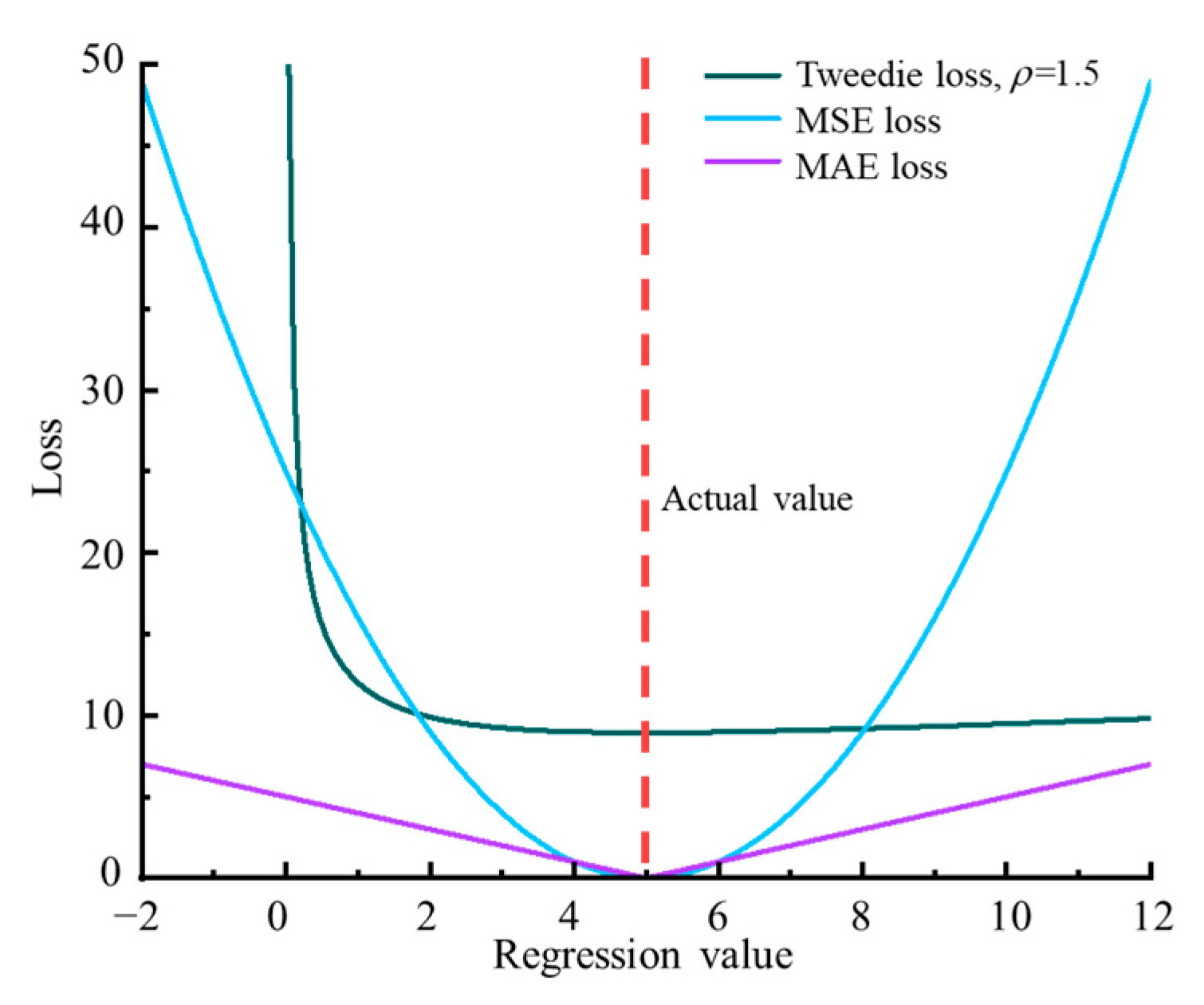
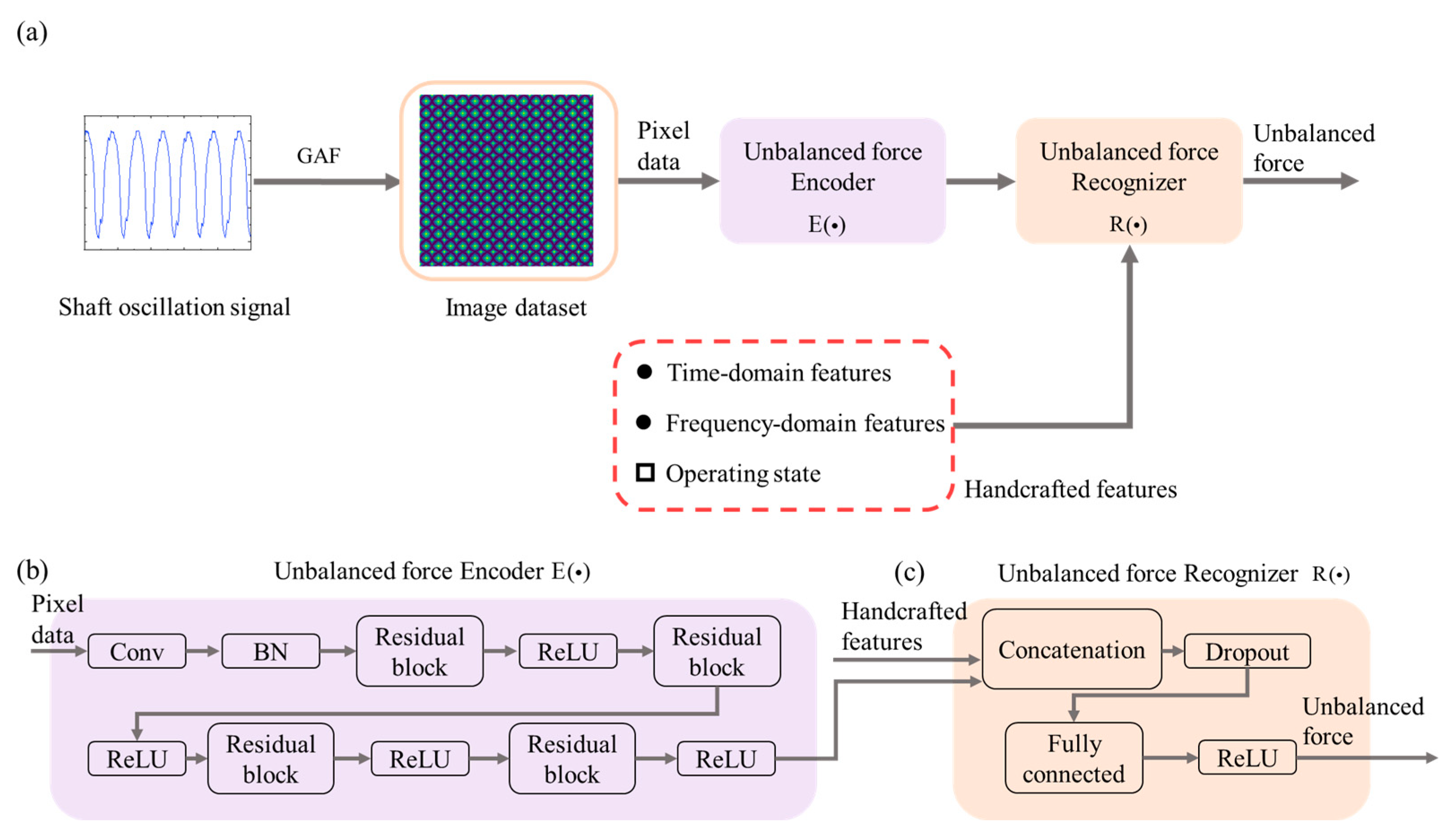
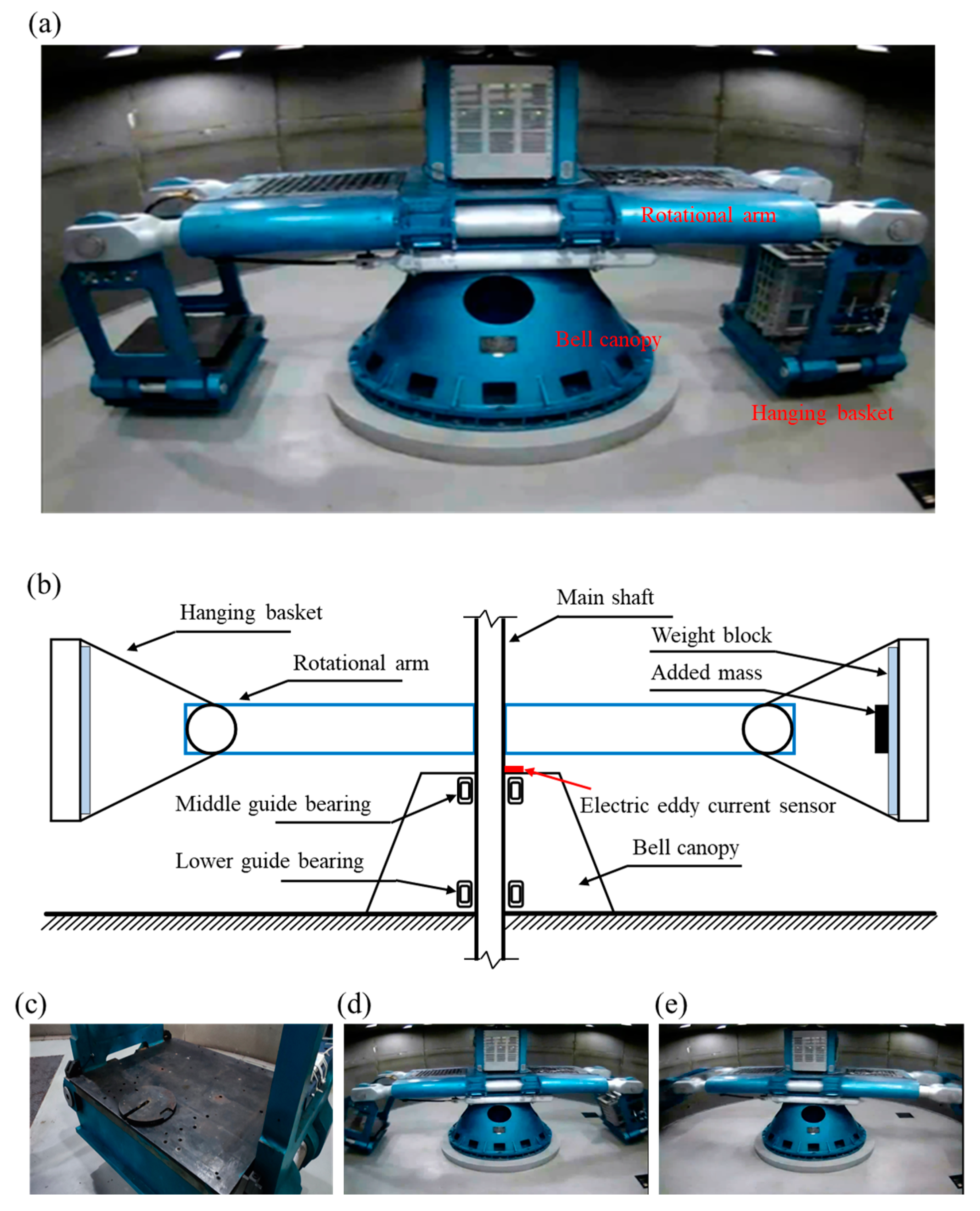

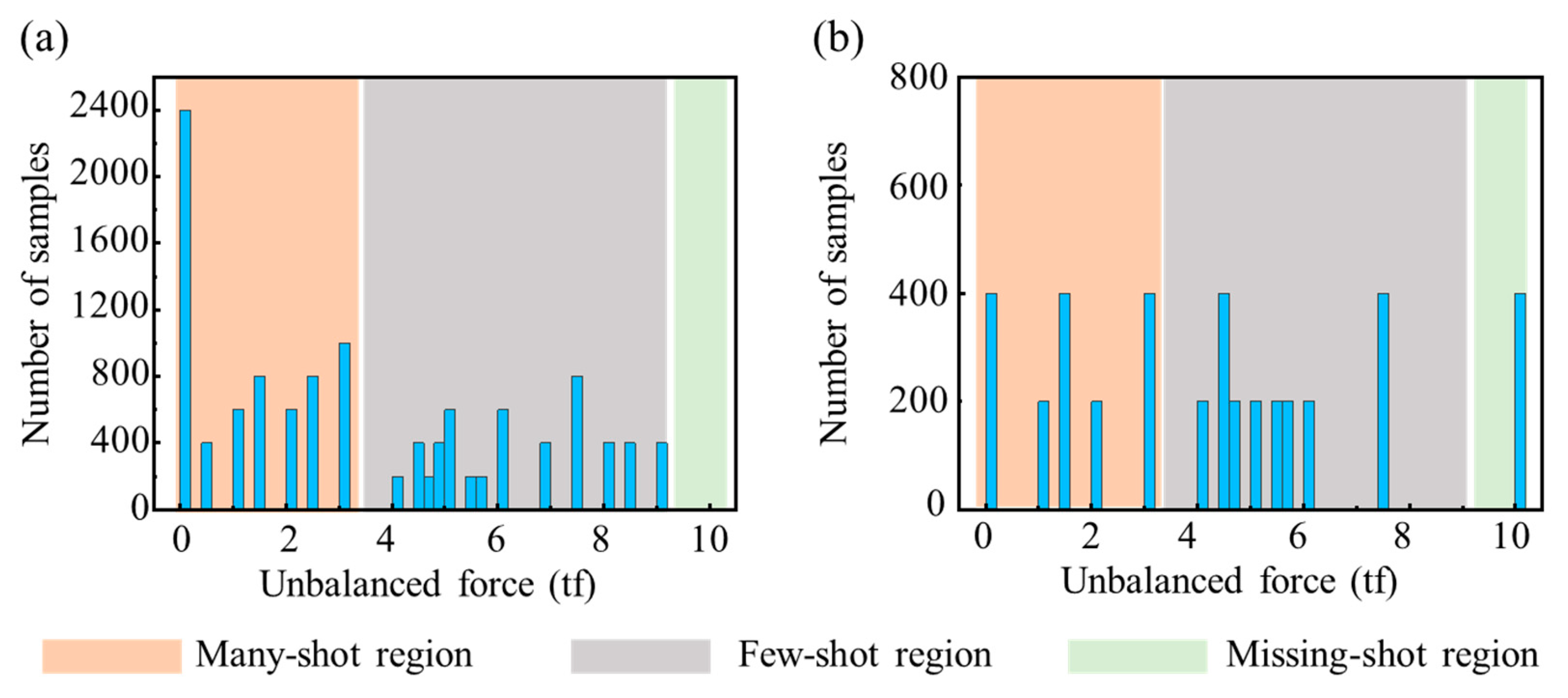
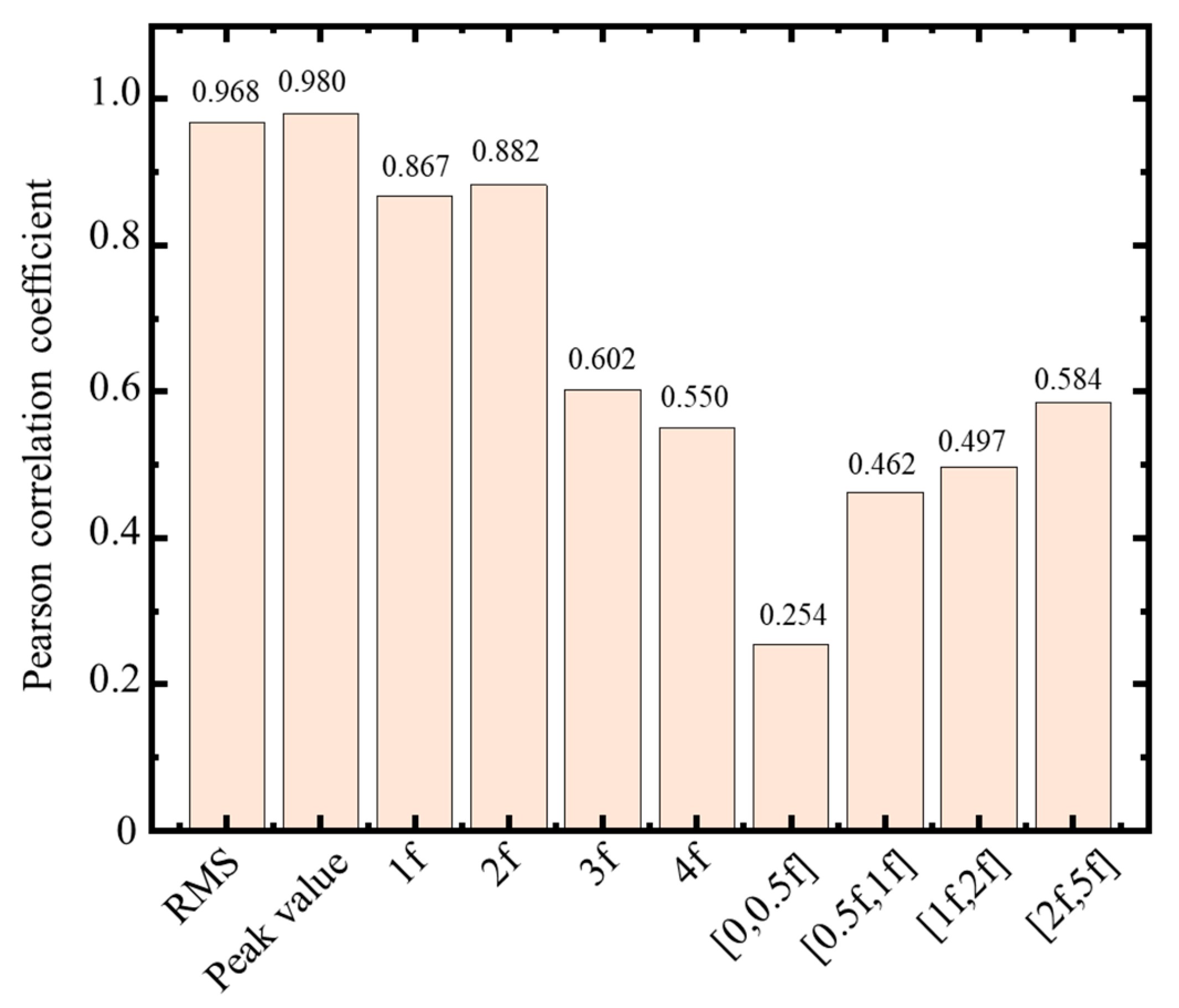



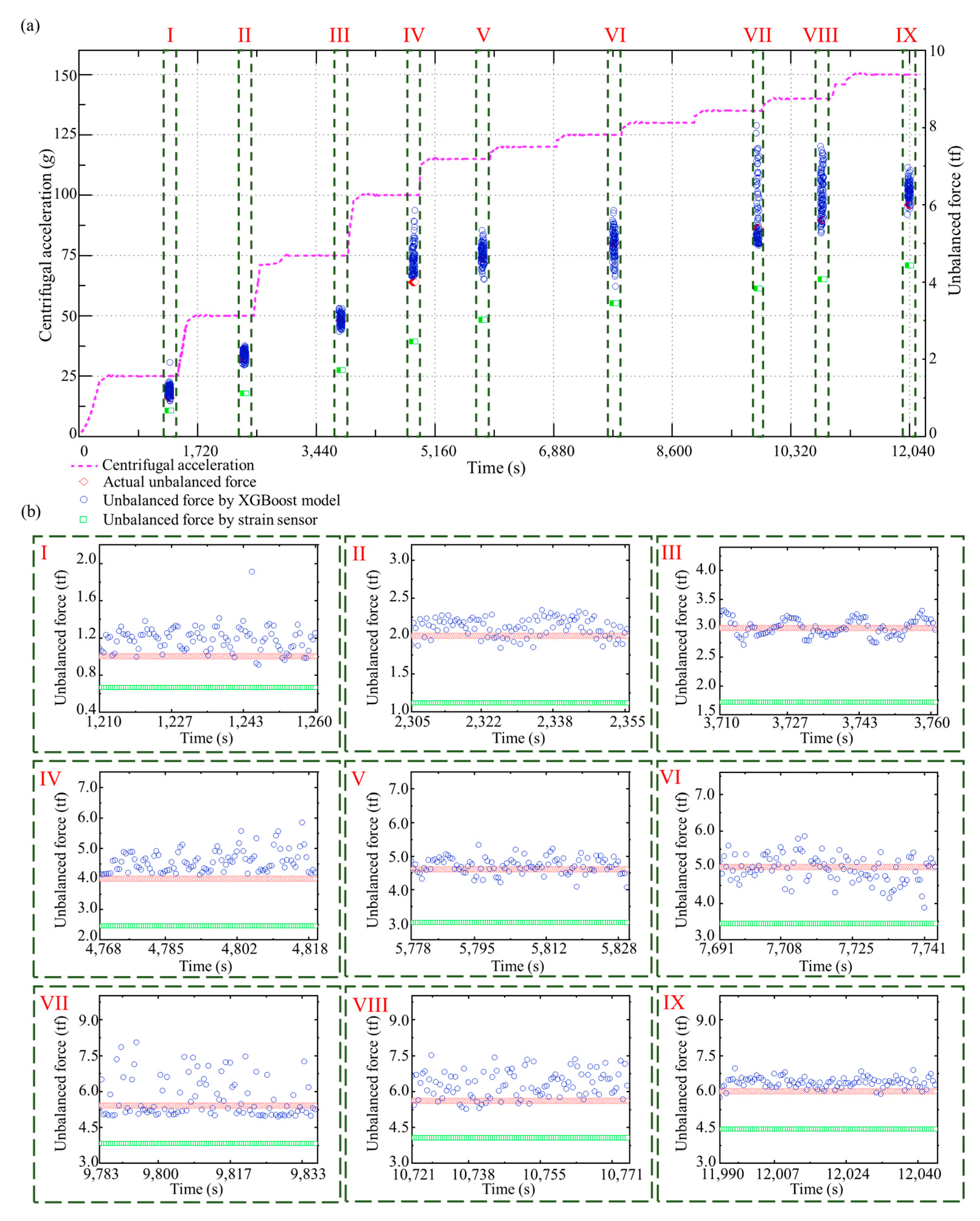
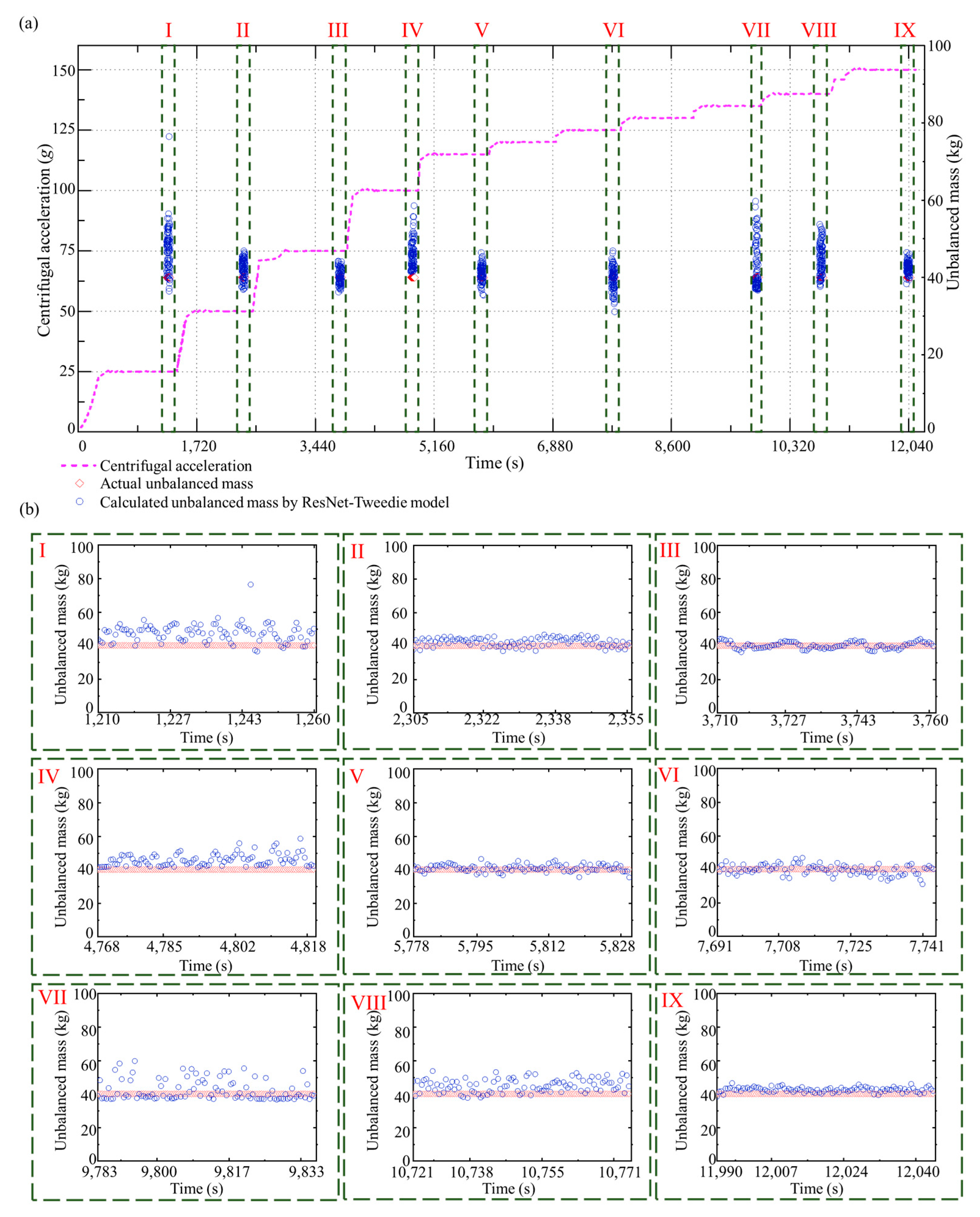
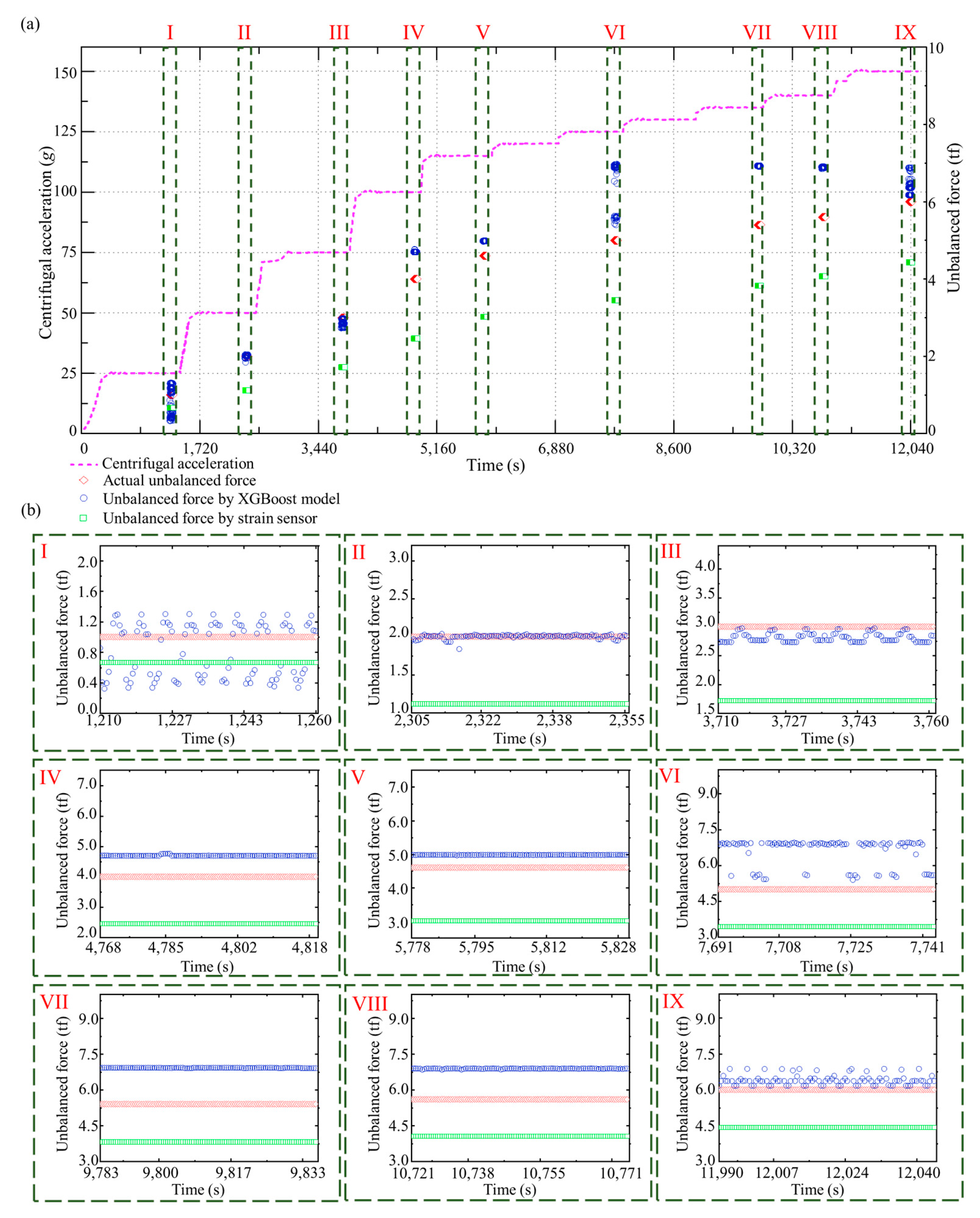

| Centrifugal Acceleration (g) | Operating Load (t) | Unbalanced Mass (kg) | Unbalanced Force (tf) | |
|---|---|---|---|---|
| Part 1 | 25, 50, 100, 125, 150 | 0, 2 | 0, 20 | 0–3 |
| Part 2 | 25, 50, 100, 115, 125, 135, 140, 150 | 0 | 40 | 1–6 |
| Part 3 | 25, 50, 80, 100, 125, 135, 140, 150 | 0, 2 | 60 | 1.2–9 |
| Part 4 | 25, 50 | 0, 2 | 100 | 2.5–5 |
| Part 5 | 25, 30, 45 | 0 | 200 | 5–9 |
| Part 6 | 25, 30, 40 | 2 | 200 | 5–8 |
| Centrifugal Acceleration (g) | Operating Load (t) | Unbalanced Mass (kg) | Unbalanced Force (tf) | |
|---|---|---|---|---|
| Part 1 | 25, 50, 100, 115, 125, 135, 140, 150 | 2 | 40 | 1–6 |
| Part 2 | 75 | 0, 2 | 0, 20, 40, 60, 100 | 0–7.5 |
| Part 3 | 50 | 0, 2 | 200 | 10 |
| Part 4 | 100 | 0, 2 | 100 | 10 |
| Whether Using the Feature Fusion Framework | MAE | Rank | RMSE | Rank | Total | |
|---|---|---|---|---|---|---|
| 1.1 | True | 0.045 | 9 | 0.38 | 9 | 18 |
| 1.3 | True | 0.034 | 5 | 0.30 | 5 | 10 |
| 1.5 | True | 0.025 | 3 | 0.28 | 4 | 7 |
| 1.7 | True | 0.024 | 2 | 0.26 | 2 | 4 |
| 1.9 | True | 0.035 | 6 | 0.25 | 1 | 7 |
| 1.1 | False | 0.048 | 10 | 0.38 | 9 | 19 |
| 1.3 | False | 0.038 | 7 | 0.26 | 2 | 9 |
| 1.5 | False | 0.025 | 3 | 0.31 | 6 | 9 |
| 1.7 | False | 0.022 | 1 | 0.36 | 8 | 9 |
| 1.9 | False | 0.040 | 8 | 0.32 | 7 | 15 |
| Model | MAE | RMSE | MeAE | EVS | MTD | R2 |
|---|---|---|---|---|---|---|
| MobileNet | 0.920 | 1.413 | 0.176 | 0.788 | 0.149 | 0.756 |
| SENet | 0.914 | 1.479 | 0.048 | 0.762 | 4.211 | 0.733 |
| ResNet-MAE | 0.724 | 1.098 | 0.206 | 0.875 | 0.167 | 0.853 |
| ResNet-MSE | 0.778 | 1.211 | 0.193 | 0.843 | 0.131 | 0.821 |
| ResNet-Huber | 0.795 | 1.294 | 0.239 | 0.824 | 0.145 | 0.795 |
| ResNet-Tweedie | 0.452 | 0.668 | 0.260 | 0.947 | 0.118 | 0.945 |
| SVM | 0.646 | 1.096 | 0.186 | 0.854 | 0.289 | 0.853 |
| ETR | 0.548 | 0.921 | 0.090 | 0.898 | 0.028 | 0.896 |
| XGBoost | 0.531 | 0.866 | 0.130 | 0.909 | 0.118 | 0.908 |
Disclaimer/Publisher’s Note: The statements, opinions and data contained in all publications are solely those of the individual author(s) and contributor(s) and not of MDPI and/or the editor(s). MDPI and/or the editor(s) disclaim responsibility for any injury to people or property resulting from any ideas, methods, instructions or products referred to in the content. |
© 2023 by the authors. Licensee MDPI, Basel, Switzerland. This article is an open access article distributed under the terms and conditions of the Creative Commons Attribution (CC BY) license (https://creativecommons.org/licenses/by/4.0/).
Share and Cite
Lin, K.; Li, Y.; Wu, Y.; Fu, H.; Jiang, J.; Chen, Y. A Deep Learning-Based Unbalanced Force Identification of the Hypergravity Centrifuge. Sensors 2023, 23, 3797. https://doi.org/10.3390/s23083797
Lin K, Li Y, Wu Y, Fu H, Jiang J, Chen Y. A Deep Learning-Based Unbalanced Force Identification of the Hypergravity Centrifuge. Sensors. 2023; 23(8):3797. https://doi.org/10.3390/s23083797
Chicago/Turabian StyleLin, Kuigeng, Yuke Li, Yunhao Wu, Haoran Fu, Jianqun Jiang, and Yunmin Chen. 2023. "A Deep Learning-Based Unbalanced Force Identification of the Hypergravity Centrifuge" Sensors 23, no. 8: 3797. https://doi.org/10.3390/s23083797
APA StyleLin, K., Li, Y., Wu, Y., Fu, H., Jiang, J., & Chen, Y. (2023). A Deep Learning-Based Unbalanced Force Identification of the Hypergravity Centrifuge. Sensors, 23(8), 3797. https://doi.org/10.3390/s23083797




